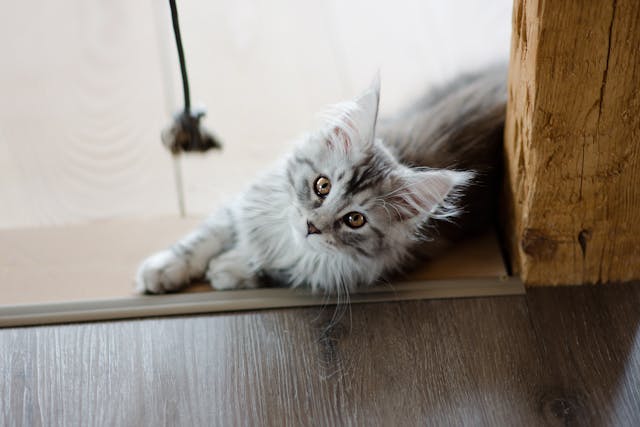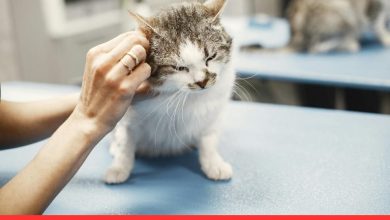5 Common Cat Ailments: Recognizing Signs and Treatment


Cats are beloved pets that bring joy and companionship to millions of people around the world.
However, like all animals, they can suffer from a variety of health problems.
In this article, we will discuss the top 5 common cat ailments, their symptoms, causes, and treatments.
We will also cover additional ailments to watch for, how to prevent cat ailments, and when to see a vet.
Top 5 Common Cat Ailments
Feline Lower Urinary Tract Disease (FLUTD)
FLUTD is a condition that causes inflammation and discomfort in a cat’s bladder and urinary tract.
It can be caused by stress, inadequate water intake, bladder stones or blockages, bacterial infections, and other factors.
Common symptoms include straining to urinate, blood in the urine, crying out or showing signs of pain before or during urination, frequent attempts to urinate, and urinating outside the litter box.
FLUTD is more common in middle-aged, overweight male cats.
Treatment involves addressing underlying causes, providing more water, prescription urinary and anti-inflammatory medications, and sometimes surgery for blockages or stones.
Dental disease
Dental disease refers to infections and inflammation in a cat’s mouth due to the buildup of plaque and tartar on the teeth and gums.
Symptoms include bad breath, red and swollen gums, loose or infected teeth, pawing at the mouth, and difficulty eating.
If left untreated, bacteria from dental infections can spread through the cat’s body.
Regular tooth brushing and professional cleanings can prevent disease.
Treatment involves a thorough dental cleaning and extraction of non-salvageable teeth by a vet.
Upper respiratory infections
Upper respiratory infections are common infectious illnesses usually caused by viral or bacterial pathogens that affect a cat’s nasal passages, throat, and sinuses.
Symptoms include sneezing, runny nose and eyes, congestion, ulcers in the mouth, loss of appetite, and lethargy.
While most resolve on their own, some cases require antibiotics and supportive care from a vet.
Respiratory infections are easily spread between cats.
Good nutrition, reducing stress, and vaccination can help prevent infections.
Ear mites
Ear mites are microscopic parasites that live in the ear canal and cause irritation and inflammation.
Signs of infestation include head shaking, scratching at the ears, dark discharge in the ears, odor, and crusty buildup in the ears.
Left untreated, ear mites can cause infections. Medicated ear drops prescribed by a vet usually resolve infestations.
Ear mites frequently spread between cats who groom each other.
Skin allergies
Allergic skin disease refers to a cat’s skin becoming irritated and inflamed in response to contact allergens in their environment, food allergies, flea bite hypersensitivity, etc.
Symptoms include repetitive scratching, hot spots, hair loss, scabs, and skin infections.
Identifying and removing the source of irritation is key.
Treatment may involve antihistamines, antiseptic baths, dietary changes, and preventing access to allergens.

Additional Ailments to Watch For
In addition to the top 5 common cat ailments, there are several other ailments that cat owners should watch for.
These include:
Obesity
Feline obesity refers to cats being significantly overweight.
Carrying excess weight puts strain on joints and organs and leads to problems like arthritis, diabetes, heart disease, breathing issues, and more.
Obese cats are also generally less active.
Contributing factors include overfeeding, lack of exercise, and genetic predisposition.
Prevention and treatment involve measured feeding, more activity and playtime, and sometimes prescription weight loss food.
Diabetes
Diabetes mellitus is an endocrine disease where the body cannot regulate blood sugar levels properly.
Most cats have Type 2 diabetes caused by obesity, though older cats may develop Type 1.
Warning signs are increased drinking and urination, increased appetite, and weight loss.
Diabetic cats require insulin therapy, close veterinary monitoring of blood glucose, a nutrition plan, and maintenance of a healthy weight.
Arthritis
Osteoarthritis is chronic joint inflammation that causes stiffness, pain, and loss of mobility in cats.
It results from wear and tear on joints over time.
Overweight cats are at higher risk.
Signs include difficulty jumping up or down, limping, and decreased activity.
Treatment aims to ease pain, slow disease progression, and improve mobility.
Hairballs
Hairballs occur when cats ingest hair while self-grooming and hair accumulates in the stomach.
Vomiting hairballs can lead to intestinal blockages.
Symptoms include retching, gagging, constipation, lethargy, and vomiting foam or tubular masses.
Preventative care includes regular brushing and hairball remedies.
Fleas and ticks
Fleas and ticks are external parasites that infest a cat’s skin and coat.
They can transmit diseases and cause discomfort, itching, infections, and anemia.
Monthly topical preventatives keep parasites at bay when applied year-round. Treatment for existing infestations utilizes flea and tick medication, bathing, and thorough home cleaning

How to Prevent Cat Ailments
While some ailments are unavoidable, implementing preventative measures can significantly reduce your cat’s risk of developing common illnesses and conditions.
Here’s a comprehensive guide to help you keep your feline friend in tip-top shape:
Veterinary Care
- Regular checkups: Schedule yearly (young cats) or twice-yearly (older cats) checkups for comprehensive examinations and early detection of potential issues.
- Vaccinations: Maintain your cat’s vaccination schedule to protect them from preventable diseases like rabies, feline distemper, and feline upper respiratory infections.
- Parasite prevention: Use veterinarian-approved flea, tick, and heartworm preventatives year-round, even for indoor cats.
Diet and nutrition
- High-quality food: Choose a complete and balanced diet formulated for your cat’s age and activity level. Avoid feeding table scraps or human food, which can be unhealthy.
- Portion control: Manage your cat’s weight with proper portion control to prevent obesity, a major risk factor for various health problems.
- Clean water: Ensure your cat has access to fresh, clean water at all times. Hydration is crucial for overall health.
Environment and lifestyle
- Stress management: Identify and minimize potential stressors in your cat’s environment, such as loud noises, new pets, or changes in routine.
- Enrichment and exercise: Provide enriching activities like scratching posts, climbing structures, and toys to stimulate your cat mentally and physically.
- Litter box maintenance: Maintain a clean and accessible litter box with unscented clumping litter.
- Dental hygiene: Brush your cat’s teeth regularly with cat-safe toothpaste and a soft toothbrush. If brushing is challenging, consider dental treats or chews approved by your veterinarian.
When to See a Vet
It is essential to monitor your cat’s health and consult a veterinarian when necessary. Below are some guidelines for determining when to take your cat to the vet based on the search results provided:
- Abnormal litter box behavior: If your cat is experiencing urinary obstruction, which presents as straining to urinate, bloody urine, frequent urination outside the litter box, or excessive licking of the genitals, seek veterinary assistance immediately.
- Repeated vomiting: Persistent vomiting, especially if accompanied by lack of appetite, dehydration, or blood in the vomit, requires a veterinary evaluation.
- Overwhelming fatigue: If your cat appears unusually lethargic, loses interest in activities they used to enjoy, or sleeps more than usual, consider scheduling a veterinary consultation.
- Sudden change in appetite: If your cat’s appetite increases or decreases significantly, it could indicate an underlying health issue, warranting a veterinary assessment.
- Dragging back legs: Aortic thromboembolism, a potentially life-threatening condition, can present as dragging back legs; seek immediate veterinary attention if you observe this symptom.
- Lumps or growths: Unexplained lumps or masses should be evaluated by a veterinarian to determine if they pose a threat to your cat’s health.
- Respiratory issues: If your cat displays signs of respiratory infection, such as discharge from the eyes or nose, or rapid, labored breathing, consult a veterinarian.
- Traumatic injuries: If your cat has experienced a traumatic injury, such as a fight or accident, seek veterinary attention to rule out internal damage.
- Coughing or breathing changes: If your cat is coughing or exhibiting other breathing difficulties, consult a veterinarian to assess the situation.
- Fever: If your cat has a temperature higher than 102°F (38.9°C), seek veterinary advice.

Conclusion
While most feline disorders cannot be completely prevented, excellent nutrition, environmental enrichment, regular veterinary care, and early intervention, when illnesses occur, give your cat the best chance at a long, comfortable life.
By understanding common cat health issues and tending to your pet’s physical and psychological needs, you promote your special friend’s well-being.
Catching problems early better enables successful treatment – and more healthy years purring on the couch with you.
FAQs
Lethargy, loss of appetite, changes in urination or defecation, fever, vomiting, coughing, etc.
Yearly for young cats, twice yearly for older cats, and more frequent if health concerns exist.
FVRCP, rabies, depending on location and lifestyle.
Regular vet care, vaccinations, proper diet, parasite prevention, and stress management.



